微透析液相色谱化学发光联用微透析技术应用于中药药动学研究张群林
- 格式:ppt
- 大小:15.75 MB
- 文档页数:68
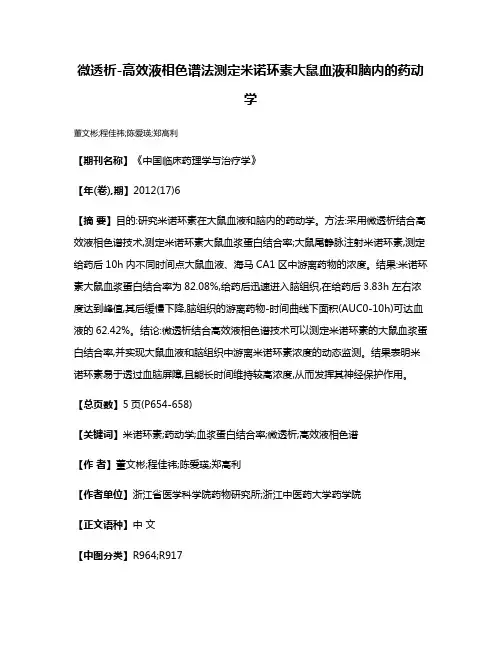
微透析-高效液相色谱法测定米诺环素大鼠血液和脑内的药动学董文彬;程佳祎;陈爱瑛;郑高利【期刊名称】《中国临床药理学与治疗学》【年(卷),期】2012(17)6【摘要】目的:研究米诺环素在大鼠血液和脑内的药动学。
方法:采用微透析结合高效液相色谱技术,测定米诺环素大鼠血浆蛋白结合率;大鼠尾静脉注射米诺环素,测定给药后10h内不同时间点大鼠血液、海马CA1区中游离药物的浓度。
结果:米诺环素大鼠血浆蛋白结合率为82.08%,给药后迅速进入脑组织,在给药后3.83h左右浓度达到峰值,其后缓慢下降,脑组织的游离药物-时间曲线下面积(AUC0-10h)可达血液的62.42%。
结论:微透析结合高效液相色谱技术可以测定米诺环素的大鼠血浆蛋白结合率,并实现大鼠血液和脑组织中游离米诺环素浓度的动态监测。
结果表明米诺环素易于透过血脑屏障,且能长时间维持较高浓度,从而发挥其神经保护作用。
【总页数】5页(P654-658)【关键词】米诺环素;药动学;血浆蛋白结合率;微透析;高效液相色谱【作者】董文彬;程佳祎;陈爱瑛;郑高利【作者单位】浙江省医学科学院药物研究所;浙江中医药大学药学院【正文语种】中文【中图分类】R964;R917【相关文献】1.基于UPLC-TOF/MS和脑内微透析技术的异嗪皮啶在帕金森病模型大鼠脑内药动学研究 [J], 卢芳;范振群;张颖;周世慧;刘树民;唐波;杨婷婷2.微透析-高效液相色谱法测定大鼠脑脊液中4种氨基酸的含量测定 [J], 韩进;万海同;别晓东;李金辉;张宇燕3.高效液相色谱法分析大鼠脑微透析液中的去甲肾上腺素 [J], 贺赛琳;岳云;张英民;郝建华;郭徽;盛志勇4.微透析和高效液相色谱法测定大鼠脑内天麻素及天麻苷元含量 [J], 吕允凤5.微柱高效液相色谱法测定大鼠脑微透析液中的乙酰胆碱和胆碱 [J], 贾兴元;吴安石;岳云;刘敬忠因版权原因,仅展示原文概要,查看原文内容请购买。
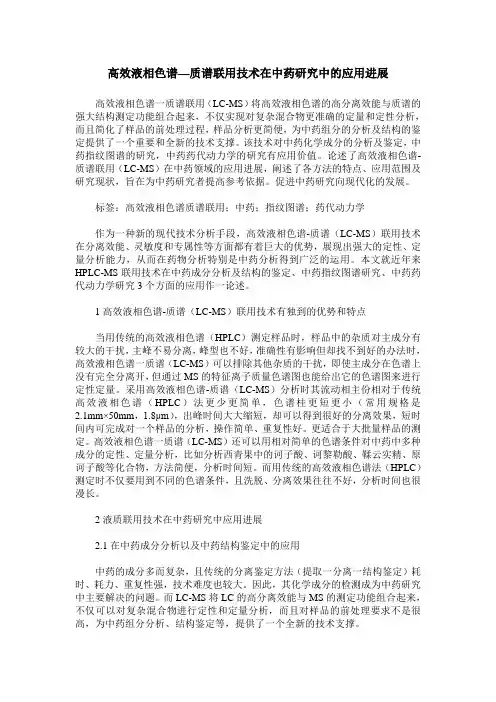
高效液相色谱—质谱联用技术在中药研究中的应用进展高效液相色谱一质谱联用(LC-MS)将高效液相色谱的高分离效能与质谱的强大结构测定功能组合起来,不仅实现对复杂混合物更准确的定量和定性分析,而且简化了样品的前处理过程,样品分析更简便,为中药组分的分析及结构的鉴定提供了一个重要和全新的技术支撑。
该技术对中药化学成分的分析及鉴定,中药指纹图谱的研究,中药药代动力学的研究有应用价值。
论述了高效液相色谱-质谱联用(LC-MS)在中药领域的应用进展,阐述了各方法的特点、应用范围及研究现状,旨在为中药研究者提高参考依据。
促进中药研究向现代化的发展。
标签:高效液相色谱质谱联用;中药;指纹图谱;药代动力学作为一种新的现代技术分析手段,高效液相色谱-质谱(LC-MS)联用技术在分离效能、灵敏度和专属性等方面都有着巨大的优势,展现出强大的定性、定量分析能力,从而在药物分析特别是中药分析得到广泛的运用。
本文就近年来HPLC-MS联用技术在中药成分分析及结构的鉴定、中药指纹图谱研究、中药药代动力学研究3个方面的应用作一论述。
1高效液相色谱-质谱(LC-MS)联用技术有独到的优势和特点当用传统的高效液相色谱(HPLC)测定样品时,样品中的杂质对主成分有较大的干扰,主峰不易分离,峰型也不好,准确性有影响但却找不到好的办法时,高效液相色谱一质谱(LC-MS)可以排除其他杂质的干扰,即使主成分在色谱上没有完全分离开,但通过MS的特征离子质量色谱图也能给出它的色谱图来进行定性定量。
采用高效液相色谱-质谱(LC-MS)分析时其流动相主份相对于传统高效液相色谱(HPLC)法更少更简单,色谱柱更短更小(常用规格是2.1mm×50mm,1.8μm),出峰时间大大缩短,却可以得到很好的分离效果,短时间内可完成对一个样品的分析,操作简单、重复性好。
更适合于大批量样品的测定。
高效液相色谱一质谱(LC-MS)还可以用相对简单的色谱条件对中药中多种成分的定性、定量分析,比如分析西青果中的诃子酸、诃黎勒酸、鞣云实精、原诃子酸等化合物,方法简便,分析时间短。
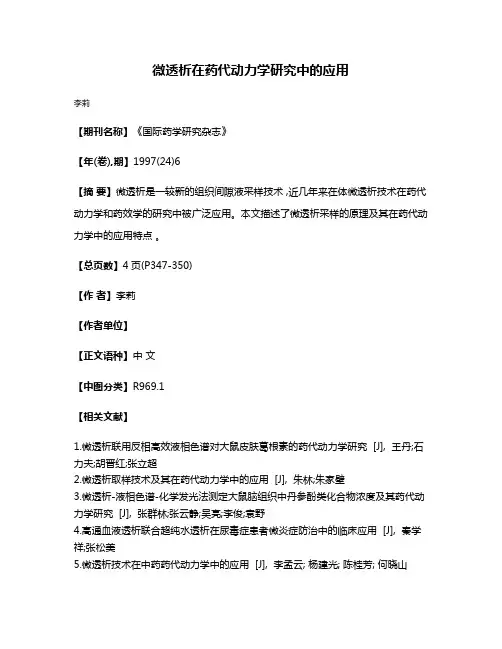
微透析在药代动力学研究中的应用
李莉
【期刊名称】《国际药学研究杂志》
【年(卷),期】1997(24)6
【摘要】微透析是一较新的组织间隙液采样技术 ,近几年来在体微透析技术在药代动力学和药效学的研究中被广泛应用。
本文描述了微透析采样的原理及其在药代动力学中的应用特点。
【总页数】4页(P347-350)
【作者】李莉
【作者单位】
【正文语种】中文
【中图分类】R969.1
【相关文献】
1.微透析联用反相高效液相色谱对大鼠皮肤葛根素的药代动力学研究 [J], 王丹;石力夫;胡晋红;张立超
2.微透析取样技术及其在药代动力学中的应用 [J], 朱林;朱家壁
3.微透析-液相色谱-化学发光法测定大鼠脑组织中丹参酚类化合物浓度及其药代动力学研究 [J], 张群林;张云静;吴亮;李俊;袁野
4.高通血液透析联合超纯水透析在尿毒症患者微炎症防治中的临床应用 [J], 秦学祥;张松美
5.微透析技术在中药药代动力学中的应用 [J], 李孟云; 杨建光; 陈桂芳; 何晓山
因版权原因,仅展示原文概要,查看原文内容请购买。

微透析-液相色谱-电化学检测联用及其应用的开题报告一、研究背景液相色谱(LC)和电化学检测(EC)分别具有高分离能力和高灵敏度的特点,在分析化学、环境监测、食品安全等领域广泛应用。
微透析(MD)技术则是一种样品前处理方法,可有效减少样品中的复杂干扰物质。
联用这三种技术可以在细胞内、生物体系和环境样品等复杂矩阵中快速选择性地检测目标物质,具有广泛的应用前景。
二、研究目的与意义本研究旨在建立微透析-液相色谱-电化学检测联用的方法,并应用于环境水样中的有机污染物检测。
通过这种联用方法可以有效提高样品前处理、分离和检测的效率和准确度,为环境污染监测提供技术支持。
三、研究内容1.建立微透析-液相色谱-电化学检测联用的分析方法:优化微透析和液相色谱的条件,建立可靠的液相色谱-电化学检测联用方法;2.选择有机污染物作为模型物,并对其进行分离检测;3.对样品预处理过程进行优化,提高检测的准确性和灵敏度;4.应用该方法检测环境水样中的有机污染物,比较其结果与传统单一方法的结果。
四、研究步骤1.建立微透析-液相色谱-电化学检测联用的分析方法:分别优化微透析和液相色谱-电化学检测方法,比较不同条件下的分析结果,确定最佳条件。
2.选择适当的有机污染物作为模型物,并进行分离、检测,确定其检测灵敏度、线性范围等性能指标。
3.进行样品预处理及提取,优化条件,提高检测的准确性和灵敏度。
4.应用该方法检测环境水样中的有机污染物,比较其结果与传统单一方法的结果。
五、预期结果1.成功建立微透析-液相色谱-电化学检测联用的分析方法,优化分析条件,并比较不同条件下的结果。
2.成功选择适当的有机污染物作为模型物,确定其性能指标,并对样品预处理进行优化,提高检测的准确性和灵敏度。
3.成功应用该方法检测环境水样中的有机污染物,并与传统单一方法的结果进行比较,证明该方法的优越性。
六、研究难点1.微透析技术的建立:微透析技术是样品前处理中的关键步骤,需要在保证减少干扰物的前提下,尽量不损失目标物。
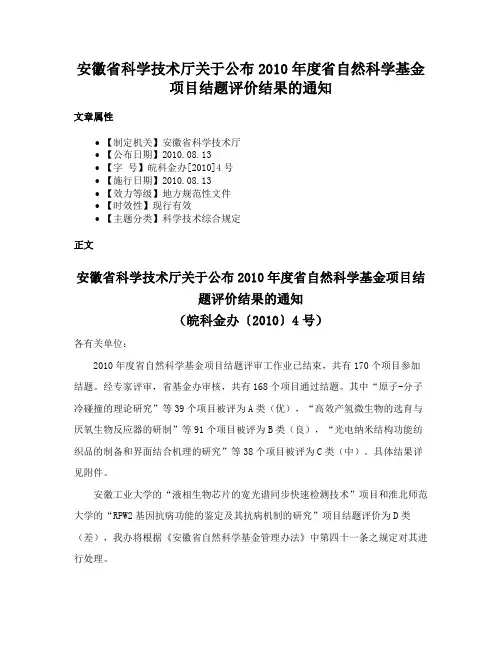
安徽省科学技术厅关于公布2010年度省自然科学基金
项目结题评价结果的通知
文章属性
•【制定机关】安徽省科学技术厅
•【公布日期】2010.08.13
•【字号】皖科金办[2010]4号
•【施行日期】2010.08.13
•【效力等级】地方规范性文件
•【时效性】现行有效
•【主题分类】科学技术综合规定
正文
安徽省科学技术厅关于公布2010年度省自然科学基金项目结
题评价结果的通知
(皖科金办〔2010〕4号)
各有关单位:
2010年度省自然科学基金项目结题评审工作业已结束,共有170个项目参加结题。
经专家评审,省基金办审核,共有168个项目通过结题。
其中“原子-分子冷碰撞的理论研究”等39个项目被评为A类(优),“高效产氢微生物的选育与厌氧生物反应器的研制”等91个项目被评为B类(良),“光电纳米结构功能纺织品的制备和界面结合机理的研究”等38个项目被评为C类(中)。
具体结果详见附件。
安徽工业大学的“液相生物芯片的宽光谱同步快速检测技术”项目和淮北师范大学的“RPW2基因抗病功能的鉴定及其抗病机制的研究”项目结题评价为D类(差),我办将根据《安徽省自然科学基金管理办法》中第四十一条之规定对其进行处理。
请各项目承担单位及时将评价结果通知主持人,认真分析本单位结题评价结果,找出存在的问题,加强在研项目管理工作,及时完成计划任务。
二○一○年八月十三日。

药物分析中流动注射化学发光分析与微透析采样技术应用研究摘要】随着医学技术的发展,面临越来越多的疾病,药物的应用也越来越广泛,对药物的研究也越来越深入,所以对药物安全性的要求也越来越严格,每样药物必不可少的就是药物分析,分析其中含量及其浓度。
化学发光分析法(Chemiluminescence,CL)是通过化学反应过程中产生的辐射光的强弱得到物质含量的一种分析方法,具有灵敏度高、线性范围宽、操作简单等特点[1]。
而将化学发光分析发和流动注射结合形成化学发光-流动注射的分析方法,大大提高了化学发光分析法测定的精密度。
微透析现在已经广泛的运用到生化物质的分析中,比如实际的器官组织以及生物液等,经过研究,它的应用范围也逐渐扩大,现在也将其应用到药代动力学的研究中,而且微透析能够和流动注射化学发光的分析发联合,形成微透析-流动注射-化学发光联用系统,能够实现在线分析,有效的测定药物在血液中的血药浓度,为临床用药提供理论依据。
【关键词】药物分析;流动注射;化学发光;微透析采样【中图分类号】R92 【文献标识码】A 【文章编号】2095-1752(2016)04-0342-021.引言1.1 化学发光的概述1.1.1化学发光的研究进程和基本原理从古至今,许多的发光反应被发现被研究,自然界中的萤火虫,还有一些海洋生物,都存在发光反应,随着研究的深入,在19世纪,有些研究人员发现某些有机化合物在被氧化时也会产生发光反应。
研究人员在不断的研究探索中提出了化学发光,并不断的将这一反应应用于物质的检测。
主要的机理为当某些物质在化学反应过程中,直接或间接的参与了反应的反应物、中间体及荧光物质,再通过吸收反应过程中的化学能,使其从基态变为激发态,而当该物质再从激发态回到基态时就会发出一定波长的光[2]。
所以在检测某物质时,便可以依据该物质在化学反应中发光的强度或这光的总量来分析该物质的含量。
1.1.2常见的化学发光体系常见的化学发光体系主要有鲁米诺化学发光体系、吖啶酯化合物化学发光体系、高锰酸钾化学发光体系和纳米粒子化学发光体系等。

收稿日期:2009-03-23; 修订日期:2009-07-29基金项目:安徽省自然科学基金项目(No .070413113);安徽医科大学博士科研资助经费项目(No .XJ2005008)作者简介:张中堂(1984-),男(汉族),安徽六安人,现为四川大学华西药学院天然药物化学方向的硕士研究生,学士学位,主要从事药用二萜生物碱的化学成分研究工作.*通讯作者简介:张群林(1973-),女(汉族),安徽无为人,现任安徽医科大学药学院副教授,硕士生导师,博士学位,主要从事中药活性成分分析方面的科研和教学工作.中药丹参有效成分的提取分离方法研究进展张中堂1,张群林1*,张云静1,丁秀年2(1.安徽医科大学药学院,安徽合肥 230032;2.安徽医科大学附属第一医院,安徽合肥 230022)摘要:综述了丹参有效成分的各种提取分离技术,其中包括超临界流体萃取技术、微波辅助萃取法、加压液体萃取法、高速逆流色谱法和真空液相层析法等,并分别对其优缺点进行分析,为丹参药理学活性物质基础的研究提供参考。
关键词:丹参; 有效成分; 提取分离中图分类号:R284.2 文献标识码:B 文章编号:1008-0805(2010)03-0728-02丹参为唇形科植物丹参Sal v i a m iltiorrhiza Bge .的干燥根及根茎,始载于5神农本草经6,被列为上品,历代本草均有收载。
其味苦、性微寒,归心、肝二经。
具祛瘀止痛、活血通经、清心除烦之功效,是一种临床应用广泛的中药。
其现代药理作用主要包括舒张冠脉、增加冠脉血流量,具有明显的钙拮抗剂作用;提高心室的顺应性,改善心脏的舒张功能,对缺血心肌和再灌注心脏具有保护作用;抑制内源性胆固醇的合成;增加微循环流速和流量,消除局部静脉血液瘀滞,改善组织细胞缺血、缺氧所致的代谢障碍;具有抗体外血栓形成、抗血小板聚集、抗内外凝血系统功能、减少血小板、促进纤维蛋白原降解作用;具有很强的清除自由基和抗氧化作用等[1]。
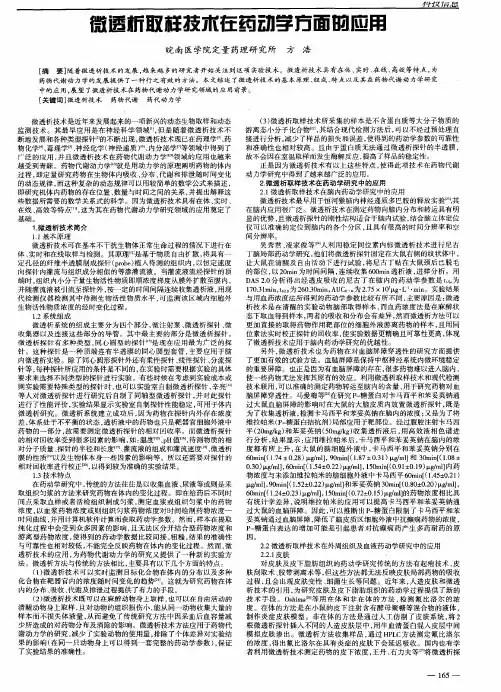


微透析和高效液相色谱法测定大鼠脑内天麻素及天麻苷元含量吕允凤
【期刊名称】《实用药物与临床》
【年(卷),期】2014(17)3
【摘要】目的考察不同剂量天麻素皮下及口服给药后大鼠脑内的天麻素及其代谢产物天麻苷元的浓度变化.方法采用脑内微透析技术进行在体动态取样,建立了高效液相-串联四级杆质谱方法测定脑透析液中的天麻素含量,建立了高效液相-二极管阵列检测方法测定脑透析液中的天麻苷元含量.结果两种给药方式大鼠不同脑区内天麻素浓度均较低,天麻苷元脑内浓度明显高于其原型药物天麻素.结论天麻素的血脑屏障透过能力差,但其活性代谢产物天麻苷元能够较好地进入脑内发挥作用.【总页数】4页(P326-329)
【作者】吕允凤
【作者单位】国家食品药品监督管理局医疗器械技术审评中心,北京,100044
【正文语种】中文
【相关文献】
1.高效液相色谱法测定不同加工工艺天麻中天麻素和天麻苷元含量 [J], 沈肖晶;金传山;许凤清;李保明;胡雨;
2.高效液相色谱法测定天麻素片中天麻素的含量 [J], 蒲恒然;陈娟
3.高效液相色谱法测定天麻素胶囊中天麻素含量 [J], 张治军;罗亚虹;周杰强
4.高效液相色谱法测定天麻及全天麻胶囊中天麻素的含量 [J], 莫志江;莫可元
5.高效液相色谱法测定不同加工工艺天麻中天麻素和天麻苷元含量 [J], 沈肖晶;金传山;许凤清;李保明;胡雨
因版权原因,仅展示原文概要,查看原文内容请购买。

脑微透析技术及其在药动学研究中的应用
韩文迪;王长连
【期刊名称】《海峡药学》
【年(卷),期】2011(023)005
【摘要】脑徽透析技术是根据小分子物质可顺浓度梯度自由扩散的原理发展而成的可连续、活体对脑内特定部位细胞外液中生物化学物质进行采集的新型采样技术.凭借自身优点,脑微透析技术越来越多地应用于药动学研究,展现了广阔的应用前景.本文简要综述脑微透析技术原理、特点及其在药动学研究中的应用.
【总页数】3页(P19-21)
【作者】韩文迪;王长连
【作者单位】福建医科大学附属第一医院药学部,福州,350001;福建医科大学附属第一医院药学部,福州,350001
【正文语种】中文
【中图分类】R969.4
【相关文献】
1.微透析技术在药动学及药动学-药效学模型研究中的应用进展 [J], 胡贺佳;陈艳;王爱民;王永林;巩仔鹏
2.微透析技术在抗精神失常药物药动学研究中的应用 [J], 何寿芸
3.微透析技术在抗菌药物药动学和药效学中的应用 [J], 刘德鼎;黄怡;肖和平;刘瑞
4.微透析技术应用于Gefitinib药动学采样的可行性研究 [J], 谢波;侯远鑫;张为民;
凌家俊;林金容;邓姗姗
5.微透析技术在皮肤药动学研究中的应用 [J], 陈芳;胡晋红;朱全刚
因版权原因,仅展示原文概要,查看原文内容请购买。
在线加压溶剂微提取-湍流色谱-高效液相色谱法同时测定管花肉苁蓉中3种苯乙醇苷宋青青;刘瑶;张玲玲;周利;屠鹏飞;宋月林【摘要】An online pressurized liquid microextraction-turbulent flow chromatography-high performance liquid chromatography ( online PLME-TFC-HPLC ) platform was configured for simultaneous determination of three phenylethanoid glycosides in Cistanche tubulosa. Micro amount powder of crude material( 0. 5 mg ) was mixed with clean diatomaceous earth and packed into a vessel which then was put into a hollow guard column. To generate high tempera-ture and high pressure,a long polyetheretherketone(PEEK)tube(1 000 mm×0. 13 mm)was linked to the end of the hollow guard column that was warmed in the columnoven( 70 ℃). The water containing 0. 1%( v/v)formic acid acted as the extraction solvent and was delivered at 2. 5 mL/min. Two electronic 6-port/2-channel valves were responsible for dividing the whole program into extraction and elution phases. The analytes were purified and enriched in a Turbo-Flow cyclone column,and back-flushed onto a Capcell PAK C 18 AQ column under a gradient elution program with 0. 1%( v/v ) aqueous formic acid-acetonitrile at the elution phase. The ultraviolet wavelength was set at 340 nm to monitor phenylethanoid glycosides. The calibration curves for the three phenylethanoid glycosides revealed good linearities in the range of 1-200 mg/L(r﹥0. 999). The limits of quantification(LOQs)were 0. 50 mg/L(echinacoside),0. 25mg/L(acteoside)and 0. 38 mg/L(isoacteoside). The spiked recoveries werein the range of 83. 13%-114. 00% with the relative standarddeviations( RSDs)between 1. 89% and 13. 34%. All the results indicatedthat this method is facile,efficient,reliable,and advantageous at time, labor,solvent,and material savings. The method also reduces the degradation risks and is suit-able for the determination of phenylethanoid glycosides in Cistanche tubulosa.%建立了在线加压溶剂微提取-湍流色谱-高效液相色谱(online PLME-TFC-HPLC)法,并将其应用于管花肉苁蓉中松果菊苷、毛蕊花糖苷和异毛蕊花糖苷3种苯乙醇苷类成分含量的同时测定。
微透析技术在中医药研究中的应用微透析技术是一种分离、收集和测定细胞内和细胞外液溶质的方法。
它通过在微透析膜上形成微孔进行微透析,进而可以实时采集样品并进行分析。
微透析技术的出现,为中医药研究提供了新的工具和方法,可以更深入地研究中药对机体的作用机制,解析中药复杂的药效成分。
首先,微透析技术可以用于中药药效成分的研究。
中药常常含有多种活性成分,研究其作用机制是中药研究的重要课题。
传统方法通常只能对整体药效进行评估,不知道具体成分的作用。
而微透析技术可以在实时且连续的基础上,对中药中的活性成分进行直接采集和分离,从而进一步研究药效成分的作用机制。
例如,研究中药对机体免疫功能的影响,可以采用微透析技术来采集和分离中药中的免疫调节成分,探索其在机体内的作用途径和机制。
其次,微透析技术可以用于中药药效成分的动态监测。
中药在体内的药效往往与时间密切相关,传统的研究方法无法实时监测药效成分的变化情况。
而微透析技术可以通过微透析膜中的微孔在线采集体内药效成分,实现对其浓度变化的实时监测。
这样一来,可以更准确地了解中药在体内的药效变化规律,为优化用药方案和研发新药提供理论基础。
例如,研究中药对肝脏保护作用的机制,可以通过微透析技术实时监测中药中的药效成分在肝脏组织中的浓度变化情况,以推断中药的药理作用。
此外,微透析技术还可以用于中药的质量控制和剂型研发。
传统的质量控制方法大都是离线的,不能实时监测中药中活性成分的释放和体外释药动力学。
而微透析技术可以通过形成的微孔采集中药中活性成分的释放速率和动力学,为中药的质量控制提供实时且定量的数据支持。
此外,微透析技术还可以用于中药剂型研发。
通过微透析技术,可以研究中药在不同剂型中的药效成分释放速率和动力学,从而优化中药剂型的设计,提高中药的药效。
综上所述,微透析技术在中医药研究中有着广泛的应用前景。
它可以用于中药药效成分的研究,动态监测中药的药效变化,质量控制和剂型研发等方面,为深入研究中药的作用机制和提高中药疗效提供了新的途径和方法。
中国组织工程研究 第16卷 第11期 2012–03–11出版Chinese Journal of Tissue Engineering Research March 11, 2012 Vol.16, No.111Department of Ophthalmology, Qingdao Municipal Hospital, Qingdao 266001, Shandong Province, China; 2Department of Ophthalmology, Shengjing Hospital, China MedicalUniversity, Shenyang 110006, Liaoning Province, ChinaWang Ya-ling ★, Master, Department of Ophthalmology, Qingdao Municipal Hospital, Qingdao 266001, Shandong Province, ChinaCorrespondingauthor: Wang Ya-ling, Department of Ophthalmology, Qingdao Municipal Hospital, Qingdao 266001, Shandong Province, China wyl8226@Received: 2011-02-23 Accepted: 2011-09-29 (20101227024/WLM)Wang YL, Wang HG, Chen XL.Microdialysis and high performance liquidchromatography detection for vancomycin concentration in vitreous chamber of conscious rabbits. Zhongguo Zuzhi Gongcheng Yanjiu. 2012;16(11): 2028-2032. ]Microdialysis and high performance liquidchromatography detection for vancomycin concentration in vitreous chamber of conscious rabbits ★Wang Ya-ling 1, Wang Hong-ge 1, Chen Xiao-long 2AbstractBACKGROUND: There are currently few studies regarding the pharmacokinetics of vancomycin via intravitreous injection. OBJECTIVE: To determine the concentration of vancomycin injected into the vitreous chamber of conscious rabbits. METHODS: A microdialysis probe was implanted into vitreous chamber of normal rabbit eyes and rabbit eyes infected withbacterial endophthalmitis for 24 hours, and 10 g/L vancomycin 0.1 mL was administered intravitreally. The drug concentration in the vitreous chamber of rabbit eyes was determined at 0.5, 1, 2, 4, 6, 12, 24, 48, 72 and 84 hours after injection, through the microdialysis and high performance liquid chromatogram-ultraviolet detection.RESULTS AND CONCLUSION: The metabolism of vancomycin showed an open two-compartment model in normal rabbit eyes. Its half-life was 51.66 hours and the peak concentration was 695.92 mg/L. The metabolism of vancomycin in the infected vitreous chamber showed a one-compartment model. Its half-life was 11.91 hours and the peak concentration was 713.35 mg/L. All rabbits were injected with drugs for 84 hours and the intravitreous concentration of vancomycin was higher than minimal inhibitory concentration. The experimental findings indicate that microdialysis coupled to high performance liquid chromatography is apowerful tool to investigate the ocular pharmacokinetics of vancomycin, and the samples are harvested in a real-time, continuous and dynamic fashion when the experimental animals are conscious.INTRODUCTIONBacterial endophthalmitis as an ophthalmicemergency usually requires the early intraocular injection of broad-spectrum antibiotics. AsStaphylococcus aureus endophthalmitis is commonly occurred, vancomycin treatment via intravitrealinjection is considered prime choice in recent studies [1]. Vancomycin has been increasingly used in thetreatment of endophthalmitis, however, there is few study available in terms of the pharmacokinetics of vancomycin metabolism after injected into the vitreous chamber.In this study, microdialysis probes were implanted into the vitreous chamber of experimental rabbits, in a broader attempt to elucidate the metabolism of vancomycin in the vitreous chamber of conscious rabbits with high-performance liquid chromatography detection.MATERIALS AND METHODSDesignA randomized, controlled, animal experiment.Time and settingExperiments were conducted in March 2008 at Department of Ophthalmology, Qingdao Municipal Hospital, China.Materials AnimalsSixteen healthy adult albino rabbits, weighing 2.0-2.5 kg, irrespective of sex, were provided from the Animal Breeding Center, ShenyangPharmaceutical University, China with license No.SCXK(Liaoning)2008-0012. Rabbits were housed at room temperature, allowing free access to water and food.StrainsStaphylococcus aureus standard strains wereprovided from the Test Center of Shengjing Hospital Affiliated to China Medical University, China. In vitro bacteriostatic tests showed that vancomycin is sensitive.Microdialysis probesMicrodialysis probes were produced by CMA/AB (Sweden), the length of effective dialysis membrane was 10 mm and molecular weight cut-off was 20 000. Main reagents and apparatus are introduced as follows:MethodsExperimental grouping and modelingSixteen rabbits were randomly divided into a control group and an inflammation group, each group contained eight rabbits, and their right eyes wereReagent and instrument Source High-performance liquid chromatography device, JS-3050 data processorKromasil C 18 chromatographic column Micro-syringe pump Potassium dihydrogen phosphate Acetonitrile Vancomycin Ringer solution Dalian Johnsson Separation Sci & Tech Corp., ChinaAkzo nobel, Sweden Bioanalytical System, USA Ghuangzhou Chemical Reagent Factory, China Shandong Yuwang Company, China Eli Lilly and Company, USA Jinan HEMOFARM Pharmaceutical Co. Ltd.,ChinaWang YL, et al. Microdialysis and high performance liquid chromatography detection for vancomycin…www.CRTER.orgselected as the experimental eyes. Staphylococcus aureusstandard strains were prepared into 2 000 cfu/mL suspension.0.1 mL aqueous humor was extracted through a puncture ofanterior chamber in sterile conditions using a 30 G needle, andthen 0.1 mL suspension was injected into the central part of thevitreous cavity of the infected rabbits at 2 mm posterior to thecorneoscleral limbus under direct vision at 3: 00 position[1-3],avoiding damage to the lens. Seventy-two hours later, the rabbitconjunctiva and corneal edema, anterior chamber and vitreousempyema, reflective red eyes and other symptoms alldisappeared, that is, endophthalmitis model was successfullyestablished (Figure 1). Control group received no intervention.Microdialysis implantationUnder anesthesia, rabbit eyes were routinely disinfected andcovered with towels, then eyelid was opened with an eyespeculum. A 5-mm skin incision was made at 0.5 cm lateral tothe upper eyelid, paralleling to the eyelid limbus, then incisionwas bluntly dissected until orbital bone. A sclerotic puncturewas conducted at 3.0-4.0 mm posterior to the corneosclerallimbus at 12: 00 azimuth, the probe handle bent to 90° (forfixation) was implanted in the central part of vitreous chamber.The probe was fixed on the sclera, orbital bone and skin, toavoid scratching when rabbits were awake[3-5]. The inlet tube ofprobes was connected with the syringe pump and perfused withRinger solution at 1 µL/min, with the outlet tube connected withthe autosampler (Figures 2, 3).Probe recoveryThe probe recovery rate was determined with in vivoanti-dialysis method. Microdialysis probes were implanted intothe vitreous chamber of rabbit eyes, injecting 50 mg/Lvancomycin solution. The perfusion probes maintained abalance for 1 hour, at an interval of 20 minutes. The dialysisfluid in the outlet tube was collected, totally three times. Theprobe recovery rate was measured with high-performance liquidchromatography according to the following formula:Probe recovery rate=(peak area of standard solution – peakarea of the solution in the outlet tube) / peak area of standardsolution[3-5].AdministrationAfter the probes was implanted for 24 hours, the consciousrabbits were placed in a cage, allowing free access to water andfeed[4-5]. The eyelids were opened with an eyelid speculum,10 g/L vancomycin 0.1 mL was injected into the central vitreouschamber (0.1 mL vitreous chamber was firstly extracted, andthen vancomycin was injected) at 2 mm lateral to corneosclerallimbus at 6: 00 azimuth. After the injection was over, theinjection point was pressed with a cotton swab for 10 minutes,to prevent drugs flow out. Ringer solution was perfusedimmediately after injection was completed, every 20 minutes.The chromatographic peak at 0.5, 1, 2, 4, 6, 12, 24, 48, 72 and84 hours was determined with high-performance liquidchromatography.Chromatographic conditionsChromatographic column was Kromasil C18 (5 µm, 25 mm×4.6 mm); mobile phase: acetonitrile 0.05 mol/L KH2PO4 (10: 90),pH 4.0; flow rate: 1.0 mL/min. Vancomycin was detected at210 nm, injection volume was 20 µL, at room temperature. Thelowest detectable limit was 0.05 mg/L[2-3, 6].Preparation of standard curveThe cryopreserved standard vancomycin 1 mg was preciselyweight and stored in 10 mL volumetric flask, then prepared into100 mg/L stock solution with distilled water and diluted bymultiple proportion. Thus a serial solution at 0.1, 0.25, 0.5, 1.25,2.5, 6.25, 12.5, 25, 50, 100 mg/L was obtained, according to theabove chromatographic conditions, the chromatograms andpeak area were recorded to conduct a linear regressionbetween peak area and concentration. Also the methodologicalprecision and reproducibility were investigated. The relativestandard deviation was < 5%. The concentration of vancomycinin the vitreous chamber was calculated with the in vivo proberecovery rate and standard curve.Main outcome measuresThe concentration of vancomycin in the vitreous chamber ofrabbit eyes was determined.Statistical analysisData were analyzed with SPSS 11.0 software for statisticalanalysis and all data are expressed as mean±SD. Theintravitreal concentration of vancomycin between the twogroups at different time points was compared with the t-test, andthe pharmacokinetic parameters of vancomycin between thetwo groups were calculated with 3p97 software. A level of Figure 1 Model of endophthalmitis in rabbit eyeSchematic diagram of the probe (effective dialysisne)Figure 3 Probes in vitreous chamber of normal rabbitsInlet tubeOutlet tubeDialysis membraneWang YL, et al. Microdialysis and high performance liquid chromatography detection for vancomycin…www.CRTER .orgP < 0.05 was considered statistically significant difference.Intravitreal concentration of vancomycinThe vancomycin concentrations in the vitreous chamber of rabbits was determined with high-performance liquidchromatography at different time points (Table 1), and results showed statistically significant difference in the concentration between the two groups at different time points (P < 0.01 or P < 0.05). Pharmacokinetic parameters of vancomycinendophthalmitis, early intravitreal injection of antibiotics can preliminarily control or reduce the inflammation, thus create favorable conditions for the following vitrectomy.Vancomycin is a glycopeptide antibiotic, its antibacterial ability depends on the interference of cellular wall synthesis, and is mainly used for clinical treatment of severe Gram-positive bacterial infections, especially for Staphylococcus aureus infection. Vancomycin has become the optimal treatment of Staphylococcus aureus endophthalmitis because it is not prone to induce bacterial resistance [2, 4, 6]. Although vancomycin is increasingly used in clinical practice, few investigations report the metabolism of vancomycin after intravitreal injection.Therefore, this study sought to elucidate the pharmacokinetic parameters of vancomycin in a conscious animal model, through the microdialysis and high-performance liquidchromatography, in a broader attempt to provide evidence for rational drug in treatment of bacterial endophthalmitis.Microdialysis technique originates from the study regardingbrain neurotransmitters, and it is currently applied as a standard sampling technique in the nerve chemistry and pharmaceutical scientific fields, serving as an important research tool inanesthesia or awake animals, especially for in vivo biochemicala: Blank sampleWang YL, et al. Microdialysis and high performance liquid chromatography detection for vancomycin…and pharmacokinetic study of deep tissue and vital organs. Microdialysis technique has been used for the sampling from many tissues and body fluids, such as brain, liver, kidney, skin, bile and blood[8]. In the research field of ophthalmology, microdialysis achieves a success in the sampling of animal vitreous chamber, aqueous humor and retina[9-11]. Microdialysis is characteristics of real-time, online, live and dynamic, it can observe endogenous substances or drugs in the body, with the following potential advantages: (1)It does not require sample pretreatment. (2)It can cause minimal invasion and maintain the normal physiological processes in vivo. (3)It is continuous and dynamic. (4)It requires a small amount of laboratory animals.Traditional study of intraocular pharmacokinetics mainly collect preoperative vitreous or aqueous humor from the patients; in animal experiments, animals are killed at different time points, then eyeballs are removed for the determination after the separation and extraction. Both methods have their intrinsic defects, first of all, samples should be separated and purified; Second, the monitoring process is not continuous and dynamic; in addition, there are a large number of experimental animals. Microdialysis technique, because of less tissue damage, can measure the concentrations of endogenous substances or drugs in awake animals. Many scholars have successfully utilized microdialysis methods to observe the drugs and their intermediate product in the retinal metabolism, transport mechanisms[12] and in the electrophysiological studies of the retina and optic nerve[13-14].In this experiment, microdialysis probe was implanted in the vitreous chamber of living rabbits, which were awake placed in a cage, allowing free access to water and food, to avoid anesthesia and human interferences and to make the experimental conditions close to physiological conditions, so this method is suitable for pre-clinical pharmacokineticstudy[11-12].This study also utilized microdialysis combined withhigh-performance liquid chromatography, to continuously monitor the chromatographic peak of vancomycin after intravitreal injection into the rabbit eyes. Results showed the maximal concentration at 1 hour after injection in both two groups of animals; the peak concentration of vancomycin was 695.92 mg/L in normal rabbit eyes, and 713.35 mg/L in the infected rabbit eyes, with insignificant differences between two groups. However, the metabolism of vancomycin was significantly accelerated in the infected rabbit eyes, the half-life period was significantly shortened, and the area under the effectiveness-time curve was significantly reduced, and the pharmacokinetic parameters showed significant differences. The reason may be that the inflammation leads to blood-ocular barrier damage, resulting in altered pathway of vancomycin metabolism in the vitreous chamber.Our experimental findings also observed that, the intravitreal vancomycin concentrations were higher than the therapeutic concentrations in all rabbit eyes at 84 hours after intravitreal injection of vancomycin. The minimum inhibitory concentration of vancomycin against Gram-positive coccus is 5 mg/L, the therapeutic serum concentration is generally considered 10-20 mg/L, and we assume that the treatment of intravitreal vancomycin is consistent with that in serum[1-2, 6]. This finding confirmed that vancomycin has a long half-life period in the vitreous body, which helps to define the administration interval of vancomycin in the treatment of bacterialendophthalmitis[1-2, 6].Vancomycin has a good elution effect on the chromatographic column, the retention time is appropriate and stable, the peak shape is good, it can completely separate with the solvent, with high sensitivity, thus achieving satisfactory results.In summary, the microdialysis combined high-performance liquid chromatography detection of the conscious animal models can meet the requirements of vancomycin pharmacokinetic analysis; achieve a continuous, dynamic and in vivo detection of vancomycin concentration in the vitreous chamber of rabbit eyes; this study confirms the feasibility of microdialysis technique in ocular pharmacokinetic study.Acknowledgments: We would like to thank Professor Wu Ying-liang from Shenyang Pharmaceutical University for providing technological support.REFERENCES[1] Del Nozal MJ, Bernal JL, Pampliega A, et al. High-performanceliquid chromatographic determination of vancomycin in rabbitserum, vitreous and aqueous humour after intravitreal injectionof the drug. J Chromatogr A. 1996;727(2):231-238.[2] Coco RM, López MI, Pastor JC, et al. Pharmacokinetics ofintravitreal vancomycin in normal and infected rabbit eyes. JOcul Pharmacol Ther. 1998;14(6):555-563.[3] Wang YL, Yu HT, Chen XL, et al. Pharmacokinetics ofvancomycin with microdialysis in vitreous of rabbits. Yanke XinJinzhan. 2009;29(11):825-828.[4] Coco RM, Lopez MI, Pastor JC. Pharmacokinetics of 0.5 mg ofa single and a multiple dose of intravitreal vancomycin ininfected rabbit eyes. J Ocul Pharmacol Ther. 2000;16(4):373-381.[5] Waga J, Nilsson-Ehle I, Ljungberg B, et al. Microdialysis forpharmacokinetic studies of ceftazidime in rabbit vitreous. J OculPharmacol Ther. 1999;15(5):455-463.[6] Macha S, Mitra AK. Ocular pharmacokinetics of cephalosporinsusing microdialysis. J Ocul Pharmacol Ther. 2001;17(5):485-498.[7] Li QY, Pang XQ, Yu J, et al. Early intravitreal injection ofantibiotics to thecurative dffects of vitrectomy for exogenousendophthalmitis. Ophthalmol CHN. 2006;15(2):132-135.[8] Wang W, Cao CY, Wang DQ, et al. Effect of preparedPolygonum multiflorum on striatum extracellular acetylcholineand choline in rats of intracerebral perfusion with sodium azide.Zhongguo Zhong Yao Za Zhi. 2006;31(9):751-753.[9] Macha S, Mitra AK. Ocular pharmacokinetics in rabbits using anovel dual probe microdialysis technique. Exp Eye Res. 2001;72(3):289-299.[10] Wei G, Ding PT, Zheng JM, et al. Pharmacokinetics of timolol inaqueous humor sampled by microdialysis after topicaladministration of thermosetting gels. Biomed Chromatogr. 2006;20(1):67-71.[11] Zhang XM, Ohishi K, Hiramitsu T. Microdialysis measurementof ascorbic acid in rabbit vitreous after photodynamic reaction.Exp Eye Res. 2001;73(3):303-309.[12] Majumdar S, Kansara V, Mitra AK. Vitreal pharmacokinetics ofdipeptide monoester prodrugs of ganciclovir.J Ocul PharmacolTher. 2006;22(4):231-241.[13] Adachi A, Nogi T, Ebihara S. Phase-relationship and mutualeffects between circadian rhythms of ocular melatonin anddopamine in the pigeon. Brain Res. 1998;792(2):361-369. [14] Qu Y, Massie A, Van der Gucht E, et al. Retinal lesions affectextracellular glutamate levels in sensory-deprived and remotenon-deprived regions of cat area 17 as revealed by in vivomicrodialysis. Brain Res. 2003;962(1-2):199-206.Wang YL, et al. Microdialysis and high performance liquid chromatography detection for vancomycin…www.CRTER .org微透析和高效液相色谱检测万古霉素在清醒兔眼玻璃体内的浓度★王亚玲1,王洪格1,陈晓隆2 (1青岛市市立医院眼科,山东省青岛市 266001;2中国医科大学附属盛京医院眼科,辽宁省沈阳市 110006 )王亚玲★,女,1968年生,山东省潍坊市人,汉族,2004年中国医科大学毕业,硕士,主要从事微透析技术在眼科中的应用方面的研究。
微透析法研究环维黄杨星D透皮贴剂透皮吸收行为
刘新国;程璐;杨全伟;张耕
【期刊名称】《中成药》
【年(卷),期】2016(038)005
【摘要】目的采用微透析法研究环维黄杨星D透皮贴剂经皮给药后的药物动力学行为.方法线性微透析探针植入Wistar大鼠真皮在线取样.液相色谱串联质谱(LC-MS/MS)法测定透析液中环维黄杨星D的回收率与其体内稳定性.结果环维黄杨星D在0.1 ~90 ng/mL范围内线性关系良好(r=0.999 34),定量限为10 pg/mL.透皮贴剂的皮肤局部药物动力学行为符合单室模型,药物平均滞留时间在12 h以上.基质药物质量浓度越高,单位时间透皮量越大,但不呈比例增加.结论经皮微透析在微创条件下,可满足环维黄杨星D透皮贴剂连续取样及动态分析的要求.
【总页数】5页(P1006-1010)
【作者】刘新国;程璐;杨全伟;张耕
【作者单位】武汉市第一医院,湖北武汉430022;武汉市第一医院,湖北武汉430022;武汉市第一医院,湖北武汉430022;武汉市第一医院,湖北武汉430022【正文语种】中文
【中图分类】R969.1
【相关文献】
1.吡罗昔康外用微乳的制备及其透皮吸收的研究 [J], 王晓颖
2.透皮吸收促渗剂的研究现状及金黄膏透皮机制的研究进展 [J], 白振丽;陈宝元;王
红;常文萍;关靖
3.特立氟胺微乳的制备及其体外透皮吸收研究 [J], 王东;曹雅茹;金涌;程节玲;颜传文
4.复方血竭微乳体外透皮吸收及抗炎活性研究 [J], 党学良; 贾丽华; 宋彦峰; 赵军; 王庆伟
5.红景天苷微乳的制备及其体外透皮吸收研究 [J], 杨克冰;徐智慧;许晓波;陈刚;黄晓军;吕伯东
因版权原因,仅展示原文概要,查看原文内容请购买。
微透析液相色谱联用的构建及在经皮药动学研究的应用的开题报告【摘要】经皮给药是一种便捷、可控、相对安全的给药方式,逐渐成为现代药物的重要研究领域。
然而,由于经皮透皮性限制和复杂作用机制,研究经皮给药药物在皮肤内疏水性和亲水性化合物的分布和吸收动力学具有挑战性。
本文着重介绍微透析液相色谱联用技术的构建及在经皮药动学研究中的应用,旨在探索一种高效、准确的方法来研究经皮给药的药物分布和吸收情况。
【关键词】经皮给药;微透析;液相色谱;药物吸收【引言】经皮给药是现代药物研究中的一个重要领域。
它通过皮肤透过作用,能够实现直接将药物输送到全身循环系统中,而不经过肠胃系统,便捷、可控、相对安全,逐渐被广泛应用于药物疗法。
然而,由于皮肤组织独特的特性,比如角质层的作用和皮肤血流动力学的限制,使得经皮透皮性限制和复杂作用机制在研究经皮给药药物在皮肤内疏水性和亲水性化合物的分布和吸收动力学方面具有挑战性。
因此,需要发展一种高效、准确的方法来研究经皮给药的药物分布和吸收情况。
【研究目的】本文旨在介绍一种基于微透析液相色谱联用技术的方法,用于研究经皮给药的药物分布和吸收动力学,为经皮给药技术的研究和应用提供理论和实践基础。
【研究方法】本文将建立微透析液相色谱联用技术用于经皮药动学研究。
具体步骤如下:1.建立微透析实验系统。
使用合适的微透析膜将质量相近的两个液体相隔离,并在微透析室和外部环境之间建立迅速平衡的状态。
2.以微透析方法采样经皮给药区域的液体。
补充一部分新鲜介质,将透析室溶液推入到注射器中并进行分析。
3.透析液样品的回收和分析。
将样品稀释再注入液相色谱分析技术中分析,测定其中的药物含量和分布情况。
4.对实验结果进行统计分析。
分析不同给药区域的药物分布和吸收情况,探究经皮透过性机制及其影响因素。
【预期结果】本文将建立微透析液相色谱联用技术,用于经皮药动学研究。
预计可以探究经皮吸收机制和影响因素,为制定和改进经皮给药技术及药物配方方案提供理论和实践基础。